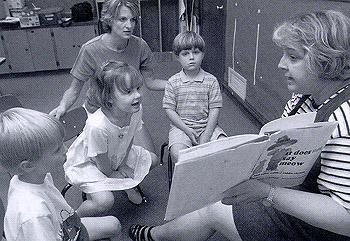Language lessons key to Wilkerson Autism program

Mary Ann McIntyre (right) and Jana Nixon work on communication skills with (from left) Clay Schulz, Stephanie Godley and Ben McNeese. (photo by Donna Jones Bailey)
One of the joys of parenthood is the eager anticipation of the child's "firsts": first smile, first steps, first words.
When those first words or the first wave "bye-bye" don't come, it can be a signal that something is wrong. For the child with autism, a delay in communication development may be the first clue that leads to a diagnosis.
Vanderbilt speech pathologists who work with autistic children say that early and intensive speech and language intervention came make a great difference in the child's success and avert or lessen behavior and learning problems. The program, offered through the Vanderbilt Bill Wilkerson Center, is unique in Middle Tennessee.
"The really young child with autism may not point, may not wave bye-bye," said Mary Ann McIntyre, senior speech pathologist. "Even if they do talk, they may begin to talk much later – using single words at 3 or 3 and half years old instead of 12 to 15 months. Parents of autistic children that we would consider 'high functioners' might say, 'He talks but he doesn't talk to me.'
"Often, the most apparent thing to the parents is not the stereotypical odd behavior that people associate with autism but rather a difficulty with communication. In many cases, we're finding that if we can address the communication issue early and intensively, the inappropriate behavior may be circumvented."
Autism is a developmental disability that typically first appears by 3 years of age. The neurological disorder affects as many as one in 1,000 individuals, who have difficulty forming social relationships, impaired understanding and use of language, and restricted patterns of activities and interests. Symptoms and characteristics of autism can be present in different combinations and with varying degrees of severity.
The Vanderbilt Bill Wilkerson program, which is available to children who have already been diagnosed as autistic, has a referral relationship with the Child Development Center of Vanderbilt Children's Hospital, which just last year established the Treatment and Research Institute for Autism Spectrum Disorders (TRIAD).
Speech pathologists began the program at Bill Wilkerson in the summer of 1993, when the need for services designed to meet the unique needs of children with autism became apparent, McIntyre said.
"That was when we started to see the numbers of children being diagnosed early start to go up," she said. "The program had five children in a group, ages 3-4, for three hours of therapy two days a week. By summer's end, word had spread and we started two more groups. Today, we serve about 80 children, ages 2-8, who are grouped by age as well as their language function ability."
The program, which includes the full-time services of five clinicians, provides speech, language and occupational therapy in group and individual settings. It is the only program in the region to offer intensive speech and language services, defined as at least four to six hours per week, McIntyre said.
"The abilities of these children range from using photos and gestures to communicate on the lower end to conversation on the upper end," she said. "The children in the middle may use a system of line drawings and symbols. The approach is that they first see it, then they hear it, then they say it."
McIntyre and her colleagues are collecting outcome data to quantify the success of the program. The study of 21 children is examining the change in the number of communication functions they are able to perform, such as directing others, requesting or rejecting something, making comments or getting attention.
"Two years into the program, the average child can perform six or seven functions, compared to maybe one or two when they entered," McIntyre said. "About 60 percent of those who entered the program as non-verbal are verbal two years later. However, the rest have developed other ways of communicating."
Research conducted by Wendy L. Stone, Ph.D., associate professor of Pediatrics and director of TRIAD, has found that the number of hours of speech-language therapy provided between the ages of 2 and 3 was associated with children's outcomes at the age of 4. That is, children who received more hours of speech-language therapy obtained higher scores on expressive language tests and had more vocabulary words as reported by parents.
"It makes sense because if the child cannot communicate, that can lead to behavior problems, to social problems, and learning problems," McIntyre said.
McIntyre said that parents should not fear having their child diagnosed because the sooner intervention can begin, the more effective it is likely to be.
"I would say to parents, 'don't fear the label because it's the label that will get you the services that can change the life of your child'," she said.













